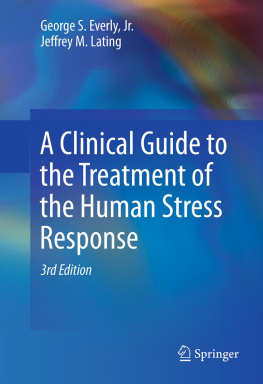George S. Everly Jr. - A Clinical Guide to the Treatment of the Human Stress Response
Here you can read online George S. Everly Jr. - A Clinical Guide to the Treatment of the Human Stress Response full text of the book (entire story) in english for free. Download pdf and epub, get meaning, cover and reviews about this ebook. year: 0, publisher: Springer New York, New York, NY, genre: Romance novel. Description of the work, (preface) as well as reviews are available. Best literature library LitArk.com created for fans of good reading and offers a wide selection of genres:
Romance novel
Science fiction
Adventure
Detective
Science
History
Home and family
Prose
Art
Politics
Computer
Non-fiction
Religion
Business
Children
Humor
Choose a favorite category and find really read worthwhile books. Enjoy immersion in the world of imagination, feel the emotions of the characters or learn something new for yourself, make an fascinating discovery.
- Book:A Clinical Guide to the Treatment of the Human Stress Response
- Author:
- Publisher:Springer New York, New York, NY
- Genre:
- Year:0
- Rating:3 / 5
- Favourites:Add to favourites
- Your mark:
- 60
- 1
- 2
- 3
- 4
- 5
A Clinical Guide to the Treatment of the Human Stress Response: summary, description and annotation
We offer to read an annotation, description, summary or preface (depends on what the author of the book "A Clinical Guide to the Treatment of the Human Stress Response" wrote himself). If you haven't found the necessary information about the book — write in the comments, we will try to find it.
A Clinical Guide to the Treatment of the Human Stress Response — read online for free the complete book (whole text) full work
Below is the text of the book, divided by pages. System saving the place of the last page read, allows you to conveniently read the book "A Clinical Guide to the Treatment of the Human Stress Response" online for free, without having to search again every time where you left off. Put a bookmark, and you can go to the page where you finished reading at any time.
Font size:
Interval:
Bookmark:
PART1
Ischemic heart disease | 12.39 DALY |
Cerebrovascular disease | 9.35 DALY |
Unipolar depressive disorders | 8.41 DALY |
Alzheimers disease and other dementias | 7.47 DALY |
Trachea, bronchus, lung cancers | 5.40 DALY |
Hearing loss, adult onset | 5.39 DALY |
Chronic obstructive pulmonary disease | 5.28 DALY |
Diabetes mellitus | 4.19 DALY |
Alcohol use disorders | 4.17 DALY |
Osteoarthritis | 3.79 DALY |
Ten leading causes of burden of disease (DALYs) by high income group, 2001 |
Recent evidence suggests that 82.8% of adults in the USA will be exposed to a traumatic event during their lifetime (Breslau, ) |
Suicide rates in the military seem to be increasing (Kang & Bullman, ) |
Twelve-month DSM-IV disorders are highly prevalent in the USA, with 14% experiencing moderate to severe cases (Kessler, Chiu, Demler, & Walters, ) |
Suicide was the tenth leading cause of death in the USA in 2007 and an estimated 11 attempted suicides occur per every suicide death |
An elevated rate of major depression was equal to the rate of PTSD in New York City residents several months after the attacks on the World Trade Center of September 11, 2001 (Galea et al., ) |
Rates of trauma occurrence related to violence, injury/shock trauma, trauma to others, and unexpected death peaked sharply at age 1620 years (Breslau, ) |
The lifetime prevalence of criminal victimization was assessed among female health management organization patients and found to be about 57% |
In 2001, the terrorist attacks against the World Trade Center and the Pentagon focus terrorism against the USA |
Of 2050 American Airlines (AA) flight attendants, 18.2% reported symptoms consistent with probable posttraumatic stress disorder (PTSD) in the aftermath of the September 11 attacks (Lating, Sherman, Everly, Lowry, & Peragine, ) |
Clearly, trauma and stress are at epidemic proportions in the USA. It seems clear that such conditions represent a clear and present danger to the psychological health of American society |
Perhaps of greatest concern, from a public health perspective is the realization that veterans returning from military service in Iraq and Afghanistan are returning home with a high prevalence of PTSD and PTSD-like syndromes. A recent review of 29 published studies revealed varying estimates of PTSD. Among previously deployed personnel not seeking treatment, most prevalence estimates range from 5 to 20%. Prevalence estimates are generally higher among those seeking treatment: As many as 50% of veterans seeking treatment screen positive for PTSDCombat exposure is the only correlate consistently associated with PTSD (Ramchand et al., , p. 59) |
Font size:
Interval:
Bookmark:
Similar books «A Clinical Guide to the Treatment of the Human Stress Response»
Look at similar books to A Clinical Guide to the Treatment of the Human Stress Response. We have selected literature similar in name and meaning in the hope of providing readers with more options to find new, interesting, not yet read works.
Discussion, reviews of the book A Clinical Guide to the Treatment of the Human Stress Response and just readers' own opinions. Leave your comments, write what you think about the work, its meaning or the main characters. Specify what exactly you liked and what you didn't like, and why you think so.









